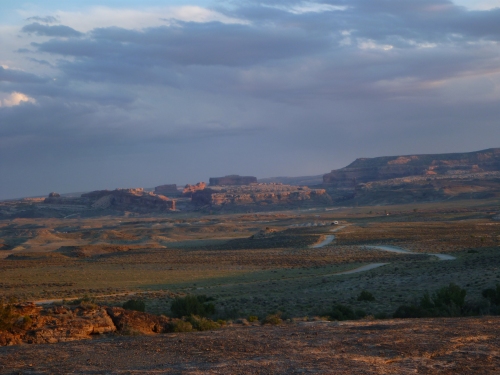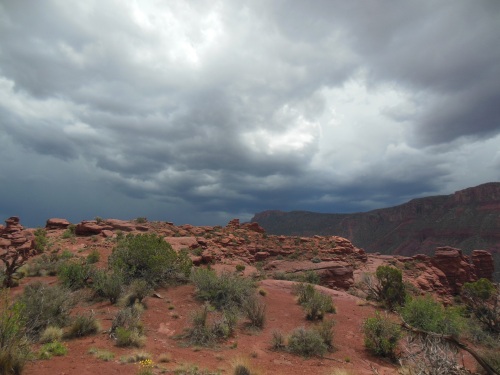I have a rather embarrassing admission to make: when I first started looking at taking a trip to the Galapagos three months ago I didn’t actually know that the islands were part of Ecuador. Two months ago I visited the islands. It was amazing, but other than one afternoon in Guayaquil on the way back to the states I really didn’t get a taste of mainland Ecuador.
But while touring the Galapagos on the National Geographic Endeavour I made friends with one of the naturalist guides who invited me to come back and visit him in mainland Ecuador. Always a fan for adventure, and with only minor apprehension about spending 8 full days with someone I had barely spent 8 full hours with, I booked tickets to Quito and packed my bag.
The Galapagos Islands are amazing. They are unique, beautiful, and biologically fascinating.

A blue footed booby in the Galapagos, with the National Geographic Endeavour in the background.
Mainland Ecuador is also amazing. It is beautiful, biologically diverse, and inhabited by generous and kind people. Ecuador has stunning biodiversity, spread over four distinct regions: highlands, jungle (Amazon), coast, and the Galapagos (600 miles due west of the mainland).

Quilotoa- more on this beautiful place later, but this is one of many spots that you can visit in the highlands of Ecuador.
I landed in Quito, the capital, late in the evening on the first where I met my friend and started our adventures. Quito airport is new, and located about an hour outside of the city. There is a nice airport express bus that takes you to the old airport in town, from where we took a taxi to Plaza Foch- a popular touristic area of Quito (there’s quite a bit of night life in this part of the city, with un-Ecuadorian high prices). It’s a fun part of town, and despite being a pricey place to eat and drink there are many affordable hostels. The night we had a room at one called “The Magic Bean” (coffee was a theme). Throughout the rest of our trip we stayed at various hostels, never making plans or reservations until we arrived. Hostels were generally cheap: we paid $19-$40/night for 2 people, always with our own bathroom, and sometimes with breakfast or breakfast and dinner included.
My first morning we wandered around Quito, grabbed breakfast, and walked around Parque El Ejido, all near Plaza Foch. Quito is in a valley, stretching from north to south (with the old colonial district in the middle, dividing “the North” (which is more prosperous) from “the South”), with mountains surrounding. The weather in Quito is lovely, and fairly constant. There’s no need for seasonal wardrobes in Quito-you can wear the same clothes year round. Since Ecuador is at the equator, sunrise and sunset are fairly constant year round, occurring right around 6am and 6pm.
Around midday we headed to a bus station on the north side of the city and took a bus to Mindo. Ecuador uses the America dollar as currency, and generally speaking things are very cheap. Public transportation within the city allows you to cross town for $0.25 (12c if you’re a senior or child), and the ~2 hour bus ride from Quito to Mindo was a mere $2.50 (a good estimate on bus rides in Ecuador is ~$1/hr).

Our first destination was Mindo…

The trip to mindo took us winding through lush mountains. Wikitravels recommended sitting on the right side of the bus for the best views and they were right. The tops of these peaks were often in clouds, though we were at lower altitudes than we had been in Quito.
Mindo is a beautiful small town nestled in cloud-forest. It is famous for the quantity and diversity of birds, and it is an increasingly popular tourist destination. My travel companion had visited many years ago, when there were a few hostels in a small town. He was shocked at the number of hostels that are there now, with many more under construction.
We stayed at the Dragonfly Inn- definitely the most luxurious of our accommodations during our 8-day adventure, with an attractive and clean room for $50/night for two of us (breakfast included). The inn is located on the main street, overlooking a small river. Hummingbird feeders attract lots of hummingbirds, and you see other birds flitting about the trees at all hours. While eating breakfast on the patio I saw at least 20 hummingbirds buzzing about.
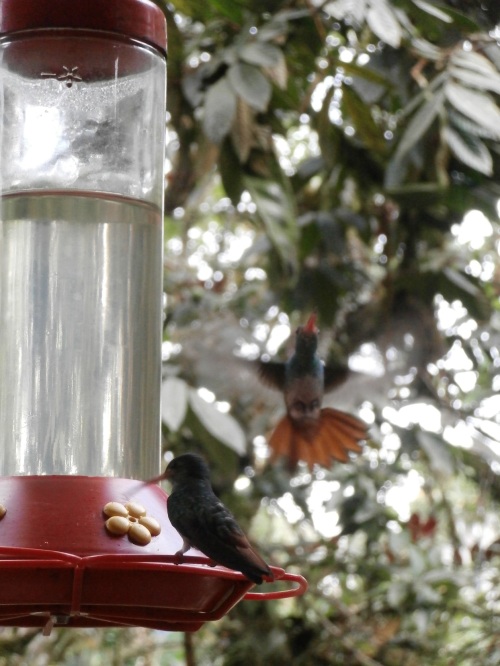
These guys were flitting around all the time and were especially active in the morning. The majority were this variety, though we did see others as well as a stunning yellow tanager.

Mindo has historically been a destination for birders, but it is increasingly becoming a hot spot for adventure tourism. During our stay we enjoyed a hike up at the cascade waterfalls and a tour of the local chocolate “factory”.
The cascades at Mindo are about 7km outside of town, and you either hike up the dirt road to the cable car that takes you across to the trails or you catch a truck-taxi. We opted for the latter option, setting up a return journey a few hours after we were dropped off (this ended up being a great set-up, as it started to pour as we finished our hike). To access the cascades you take a ride on a generator-powered cable-car that takes you on a ~900m ride across a deep ravine. Our car-operator would give any OSHA inspector a heart attack, as he opted to stand outside the metal cage as we zoomed along, hundreds of feet above the forest floor.

About 900m long, and absolutely stunning… A breathtaking way to reach a trailhead!
Once on the other side we opted to hike to the Reina Falls (there were a couple of trail options). There were many small falls along the way, and we spotted many hummingbirds and flowers along our hike. The final falls, Reina Falls, required a climb up a rather sketchy set of stairs.
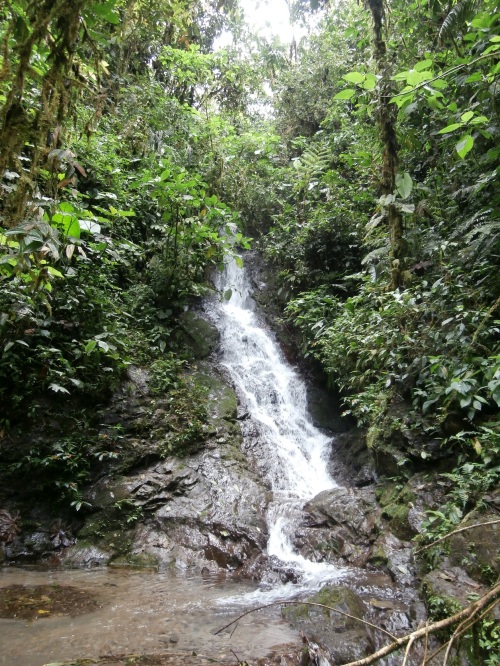
One of the small falls along the trail to La Reina falls. Everything was so green and alive!
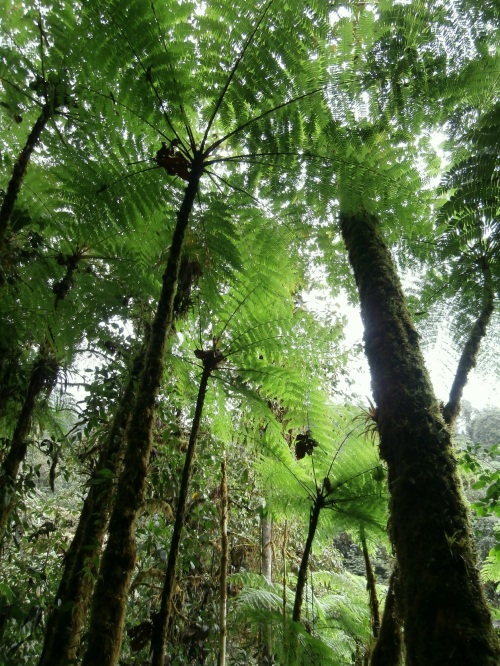
I loved these massive tree ferns.
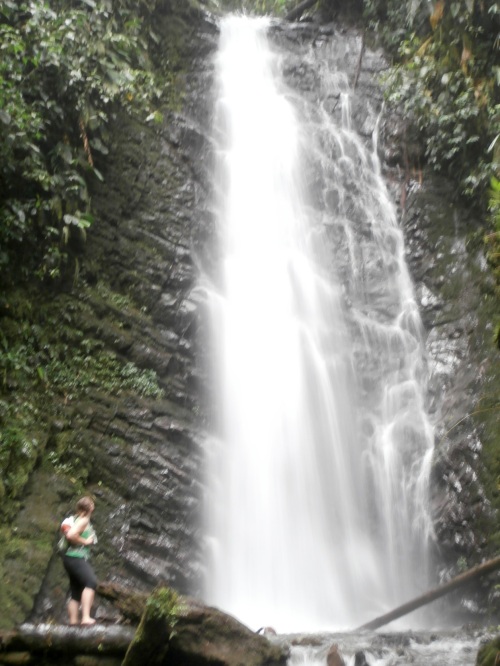
La Reina falls.

Heading back down the sketchy stairs after we’d visited the falls.
Alas, it started to pour towards the ends of our hike, so our cable-car ride back to the taxi was a wet one. Had the weather been nicer, and had we had the interest, there are a number of outfits that offer canopy rides in the area.

A slightly soggy ride back!
We had lunch at a little café (trout is a regional specialty, and was delicious), where we had a long discussion with the café owner about the various challenges Ecuador faces when it comes to attracting tourists. While we chatted (first in Spanish, then in English) the owner caught on to my interests in agriculture and food, and insisted on running to the market next door where he purchased a naranjilla and a taxo (banana passion fruit) for me to try. Both have distinct and interesting flavors and are generally used for making fruit juice, for which they usually require some sweetening (“jugo natural”= freshly made juice, which is very popular in Ecuador. A glass of some sort is usually served with breakfast and lunch).

Taxo (above) and Naranjilla (below)
In the afternoon we headed to El Quetzal Chocolate Factory (Factory is probably a bit of an over statement, as operations take place in a small shed and two processing rooms), where we went on a tour and learned how they made chocolate- bean- to bar (actually pod to bar).

Cacao trees have many pods on them at one time and they sprout directly from the trunk or branches. They ripen at different times, and are red and yellow when mature. The best beans grow at lower altitudes, so El Quetzal doesn’t use the pods from their plants in Mindo (somewhere between 1000 and 2000m altitude) for making chocolate. Instead they use these for decoration and/or share the fresh pulp amongst the workers as a snack.
Pods are broken open to acquire the beans, which are fermented, as well as the white pulp, which is cooked down into a thick syrup that they call Miel de Cacao. I really liked the flavor, which had elements reminiscent of balsamic vinegar. In Mindo the cacao beans are fermented and dried in a plastic-sided green-house- the smell is intoxicating
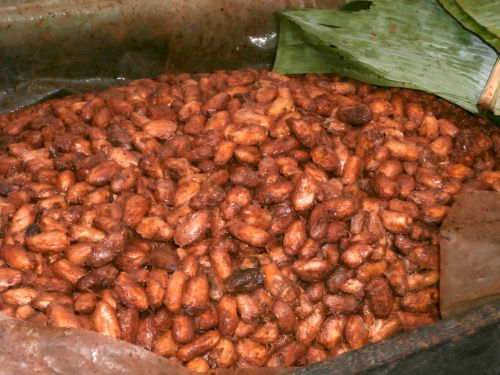
Beans ferment for a few days to a week, depending on the temperature. They are wrapped in banana leaves to conserve heat.

The heat from the fermentation process kills the “embryo” inside. Initially these embryos start out purple, and they become brown as they cook and die. Brown (dead) embryos make good chocolate (there’s a reason chocolate is brown and not purple!). This one is on it’s way to being ready, but is still quite purple.

Once fermented, beans are laid out to dry. Drying time depends on the temperature in the house.
Once the beans are dried, any bad ones are removed and the remaining beans are roasted and cracked. The nibs are separated from the shells by a winnower.

The Roaster- Much like the fermenting and drying room, the smell in this room was intoxicating.

This is what you get after you roast the beans: nibs and shells. Throughout the process we were encouraged the try the beans. As someone who enjoys 100% cacao, I enjoyed nibbling on the nibs. Not so for the other 3 people on the tour.
Next, production moves into the first processing room where beans are ground. Here the beans were either made into 100% cacao paste, or separated (with pressure) into cocoa butter and cocoa powder. The thick chocolate paste, known as chocolate liquor, is then made into chocolate bars by adding sugar and extra cocoa butter. The mixture is refined, conched (ground and processed for a long period of time- I believe over 24 hours), and then tempered. El Quetzal doesn’t add any emulsifiers (such as soy lecithin), and instead relies on extended periods of conching and tempering to get a lovely smooth mouth feel and texture. They make a few different bars with various amounts of sugar and some added ingredients, such as ginger, chile peppers, and coffee- all of which they grow in Mindo (they also ferment a potent, and delicious, ginger beer).
I could have spent a couple of days in Mindo, but the next morning we headed back to Quito so that we could catch another bus to Otavalo.

The route to Otavalo.
Otavalo is a (relatively) large city in Imbabura province that is largely inhabited by native people. Otavalo is known for it’s large market (mainly selling locally manufactured textiles and leather goods), which has made the city and its people prosperous. The market is open every day of the week, but the largest market is on Saturday. We arrived on Friday evening, found a hostel (for $19/night for 2 people), took a brief walking tour of the market area, had some dinner, and called it a night.

The market in Otavalo, as business was winding down on a Friday night.
On Saturday morning we woke up early to go to the Mercado de Animales. This market is only open on Saturdays, and is where locals go to sell, buy, and trade all sorts of animals: cows, pigs, goats, sheep, llamas, chickens and assorted poultry, rabbits, and guinea pigs (known as cuyo). I’ve never seen so many pigs on leashes…

Early morning in the mercado de animales.
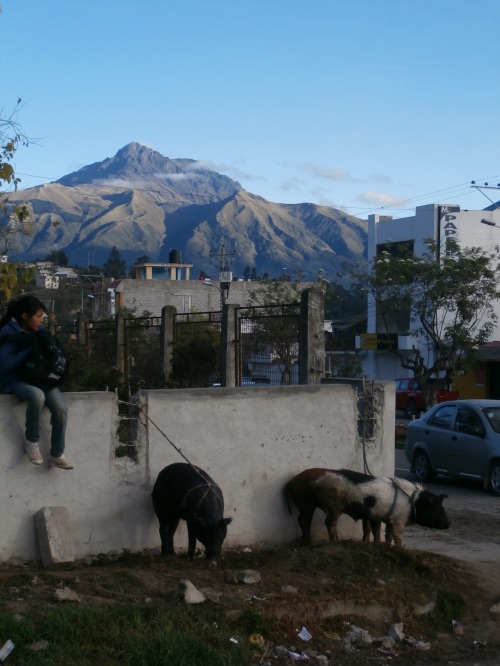

Looking out over the cow section.
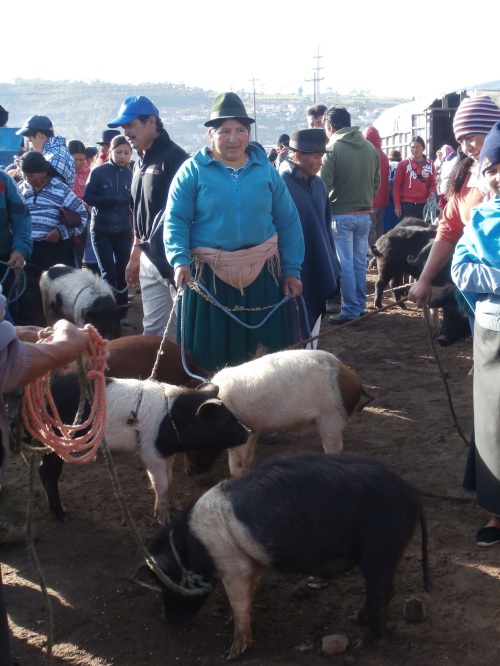
Pigs on leashes!

Piglets on leashes! (I thought the spotted ones were very cute)
One of the few things I found in Ecuador that was actually more expensive than at home in the states was old laying hens. Here I know farmers that get $2.50/bird for old laying hens, while they were selling well for $9 a pair in this market. “Galina” (hen), has more flavor than regular meat chickens “pollo”, at least according to my travel companion!

A woman wearing her baby and selling Gallina (old laying hens). At $9/pair, these are more expensive than in the US!

Lots of Gallina: hens that have stopped laying eggs.

Alternatively, you could buy pollo- meat chickens (I didn’t catch the price).

I asked if you could buy laying hens (what we would call pullets), and was told that no one would sell a good laying hen. You could buy chicks though- I assume the brown paper bags on the side are for transportation once sold.

Guinnea pigs are a traditional meat source in this part of the world, and were prevalent in the market.

A mix of guinneas and rabbits.

People shopping in the Otavalo animal market. It’s kind of nice to be in a market where no one is trying to sell you anything. It’s pretty obvious that tourists won’t be taking anything home, so you’re left to wander around and people-watch to your hearts content.
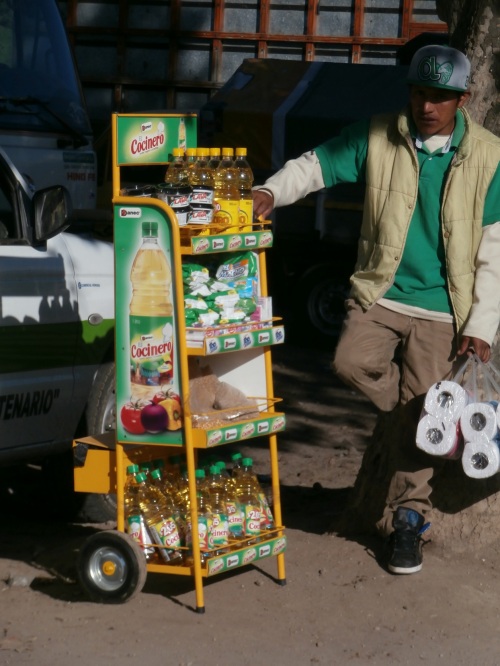
Vegetable oil- the bane of my existence… I was sorry to see this guy selling vegetable oil at the animal market. Why abandon lard! (They’re getting the “animal fat is bad for you, vegetable oil is good for you” story in Ecuador these days.) While people cook most things from scratch outside of the big cities, there were lots of billboards marketing pre-made convenience foods as the way of the future.
After leaving the animal market (and passing through the small black-market out front where people sold animals without having to pay the $1 fee for trading animals in the market) we headed back into town to check out the main market. On market day, the central square and two main streets are full of vendors selling silver, leather goods, antiques, and clothing made in and around Otavalo. I couldn’t resist coming home with a small collection of scarves (made of locally produced cotton) which I bought for $2.50-$3 each. The main materials produced and used for textiles in the area are wool, cotton, and alpaca, and while most things are made in bulk on machines you can still find a few vendors that hand-make their own items.

I bought a few scarves from this young lady, who sold alpaca and cotton scarves, as well as wool hats that she knits herself (I somehow resisted the sponge-bob hat). She was very smiley while we chatted but became very serious when I asked her if I could take her picture.
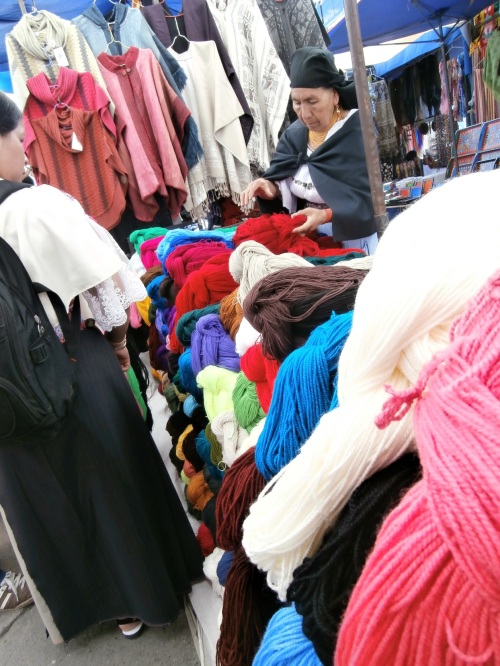
I loved the colors of these locally produced wools.
Some general observations of the people in Otavalo:
The majority of people in Otavalo are indigenous Ecuadorians, and while they generally speak Spanish they also speak their own dialect of Kichwa. The women frequently wear traditional embroidered blouses with matching ribbons wrapped around their pony tails. They often wear hats, but will substitute a folded up blanket on their head to keep the sun out of their eyes in a pinch. The women generally wear flat sandals or shoes, and have no qualms breastfeeding in public. Babies are frequently worn in makeshift slings on mothers’ backs, and I didn’t hear or see an unhappy baby the whole time we were there.

A folded blanket doubling for a hat in the animal market. Women will walk around all day with a blanket like this.
In the afternoon we headed to Cotacachi- another predominantly indigenous town- famous for leather work. After meandering the main stretch and grabbing lunch (a delicious $7 per person “menu del dia” that consisted of traditional ceviche, plantain soup, a trout main dish, and strawberries with cream), we got back on a bus to make our way to Vale de Chota via Ibarra.
Valle del Chota is not a typical tourist destination.
Valle del Chota is a region in Imbabura province with a number of small villages and towns occupied largely by Afro-Ecuadorians. Along with the Esmeraldas province, Valle del Chota is one of the two areas in Ecuador largely inhabited by black Ecuadorians (descendants of former slaves and those who escaped from wrecked slave-ships coming from Africa). The villages in this area are generally rather poor (with some living in abject poverty).

Onwards to Valle de Chota
Perhaps some would find a visit to Valle de Chota interesting because of the heritage of the people or to see the difficulties of living in poverty, but we came for another reason… While people in this area traditionally scratched out a living trying to do agriculture in a very dry environment, this area has now become famous for the production of something very different- futbol (that’s soccer for Americans) stars.
Despite being a mere dot on the map of Ecuador, this region has produced half of the players on the last two Ecuadorian world cup teams. Players from these towns compete in Europe and around the world, and are internationally recognized as sports stars. While I have no interest in soccer my travel companion is a huge futbol fan, so exploring these towns was of great interest to him.
We started our morning in Pusir Grande- the most impoverished place I have ever visited. The easiest way to get to this village is on foot over a large suspension bridge built in 2004. In Pusir we spoke with a pair of older women who told us about life in the village. It was not a pretty picture, with no real jobs, no real opportunities, and no real way out.

The bridge to Pusir.

The view from the bridge is stunning, but the sights in the village on the other side take your breath away for totally different reasons.

Pusir Grande- Absolute poverty- there really isn’t much for me to say.
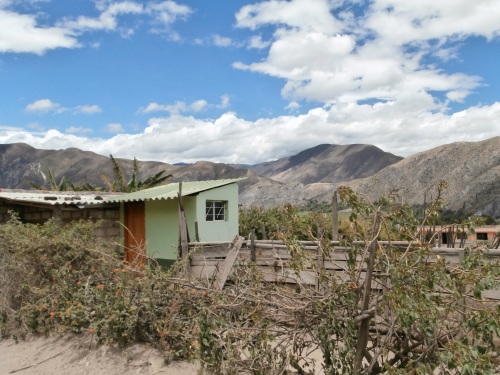
From Pusir we took a taxi to Juncal. The taxi was driven by a local young man who was excited to have some tourists visiting his area. When he heard our reason for visiting he told us that he would take us on a detour through his town of Carpuela, where he proudly pointed out the houses of family members of various famous soccer players (the names meant nothing to me, but my companion was excited). Carpuela was definitely better off than Pusir, and conditions continued to improve as he hit Juncal (though I would not call the area prosperous).
In Juncal we had a traditional lunch of Fritadas (fried pork served with a couple types of corn and potatoes).

Fritadas
We then walked through town, eventually meeting up with a group of young boys who found a couple of out-of-towners very entertaining. They took us down to the river and regaled us with stories, attracting more young boys with their shouts and laughter. I spoke to them all with my basic Spanish, and as each new boy showed up they asked me “Conoces Libby?” (Do you know Libby?) Apparently they have a visiting American teacher named Libby. The boys were also fascinated by how my friend and I could be together because my Spanish was so bad… For some reason they had a hard time believing that he was fluent in English.

These guys were great and full of life. Maybe one will be a famous soccer star some day.

I spotted this girl watching us on our walk back to town. Only the boys came up to us to say hello.

Under the bridge- this is where some of Ecuador’s best soccer players grew up, with this field being the training ground for World Cup players.
On our way back through town we stopped to watch some Ecuavolley. As the name suggests, this is a variant of volleyball, invented in Ecuador. The game is played with a soccer ball (it’s hard enough to afford one ball, you might as well use it for multiple sports), and is played three-a-side. During my stay in Ecuador I watched a number of these games (my companion is an avid and accomplished player). At this game, and throughout our stay in Valle del Chota, I stood out like a sore thumb (as did my relatively pale Ecuadorian friend) but while our presence drew some interested looks we never had any issues and were frequently offered assistance (because surely we were lost!).

A street game of Ecuavolley.

It looked like fun. I’d certainly like to try it out!
In the afternoon we again headed back to Quito. While we easily navigated Ecuador by bus, we always had to return to Quito to start a new adventure, with it acting like the hub of our travel wheel. We again spent the night in Plaza Foch, before heading south to Quilotoa (changing buses in Latacunga- the capital of the Cotapaxi province).

The roads to Quilotoa…
Quilotoa is a beautiful crater lake in an area sparsely populated by native people. Due to it’s growing popularity as a tourist destination, the locals have moved from their old village which was located about 1km down the mountain and are now living up at the edge of the crater where you can find many hostels and small cafes or stores (every building is a café, store, or hostel, as all the inhabitants make their living from tourism).

One of the many hostels in Quilotoa,flying the Incan flag.
My friend had visited Quilotoa 15 years ago, when you had to hire a truck to take you up the dirt road and the only thing at the top of the crater was a small adobe hut. In the last few years the government has paid for the construction of a nice new road to the village as well as the construction of a handicapped-accessible viewpoint and a maintained trail down to the lake. With these changes, tourism continues to increase, though there weren’t many other visitors during our stay.

This nice wide trail is a relatively new addition to the landscape at Quilotoa.
We opted to stay at one of the first hostels we saw- a recently constructed large chalet with beautiful large rooms heated with wood burning stoves. At almost 4000m (12,841 feet) and exposed to the elements, it’s windy and chilly in Quilotoa and we were certainly appreciative of the stove in our room and in the common area. For $20/person we not only had a room, but also had a dinner and breakfast that we shared with the other visitors (including four Indians who are on a months-long journey culminating in a trip to the FIFA World Cup in Brazil and a young Japanese woman on a solo year-long trip around the world!).
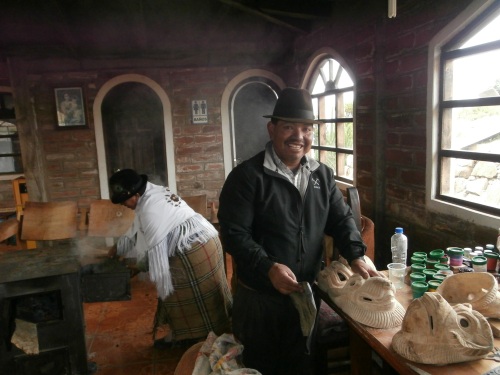
In addition to running a hostel, the owner of this establishment makes and sells wooden masks. In the back you can see him wife tending to the wood-burning stove.
We got to Quilotoa in the early afternoon. We had lunch at a small café associated with our hostel (a $4 menu del dia consisting of a bowl of lima bean soup, a plate of chicken, potatoes, and rice, and a glass of fresh-squeezed juice) and then headed to the crater. Despite a bit of concern that we may not make it down and up the crater before dark, we headed off down the trail. There we chatted with a local guy who was maintaining the trail. I figured that these guys must be used to tourists, so I asked him if he would take a picture of us with my digital camera. My assumption was wrong, and I don’t think I’ve ever seen someone have so much trouble taking a picture. Eventually there was success, and while the picture may be crooked, and you may see only part of the crater lake, our smiles were certainly genuine.

My travel companion is a photo instructor for National Geographic, a skill that definitely came through in some of the pictures that he took with my camera!
It probably took us about half an hour to make it to the bottom of the lake, and I’ll admit that a couple times I found myself concerned about our ascent up the steep path, especially with the added difficulty of catching our breath at altitude. At one point we passed a local giving a tourist a ride up the trail on a horse, but we declined his offer to come back and get us from the base.

The lake at the base of the crater. The colors of the lake are amazing, and changed with the angle and intensity of the sun.
At the bottom of the crater you can rent Kayaks for $2.50/hour, but they had shut-up shop by the time we got there. There is also a very basic hostel on the shore, which provides a bed and breakfast for ~$12 a night with access to a pit toilet. There are no wood-burning stoves in these rooms, but it was much milder down in the crater than up at the rim. We found a young local down at the hostel, and we chatted to him a little bit before starting our hike back to the rim. He said it takes him 25 minutes to hike back up, though I’m sure it took us well over twice that.
On our return hike we opted to take a different path, rather than the maintained trail. It was very challenging, but the views on this hike up and down were absolutely breathtaking. The water is a stunning blue, with the color changing dramatically depending on the light. The water is brackish and full of minerals, as verified by my hiking partner who bravely took a sip, and I’ll admit I would have loved to of taken a dip had it been earlier in the day.

This llama was hanging out on the side of the caldera as we hiked back up.
After our hike we visited one of the small shacks that served food. We had coffee and struck up a conversation with one of the locals. My companion asked a lot about how the village had changed since his last visit and I asked a lot about life in Quilotoa. We learned that people are getting married much earlier now than they had previously- now sealing the deal as early as 14 or 15. We learned about their marriage traditions (BIG parties) and that most people have about 8 children.
The clothing of the native people living in Quilotoa was notable different from that of the people living in Otavalo, which makes sense since the weather is much more severe. Hats are popular for both genders in both locations, though the preferred style is quite different in each place (and I noticed that many of the hats were adorned with peacock feathers in Quilotoa, a style I hadn’t noticed in Otavalo). I also noticed that while most women in Otovalo wore flats, all the women in Quilotoa wore heels. When I asked the guy about this he replied in Spanish that “they just like it… though it does make them too tall”. We spoke to everyone in Spanish, but the local language in Quilotoa is another dialect of Kichwa. We were told that they can understand the dialect from Otavalo, but that it’s different.

We had a great time chatting with this gent. As we drank coffee in the corner, women cooked dinner on the burners behind us while men played cards.w
I asked about childbirth for the local women and was told that some chose to have their children in hospital while others give birth at home with midwives. During my time in the Andes I was struck by the prevalence of nail clubbing. This is one of those things that medical students learn about in med school, and rarely see (I had a couple patients with clubbing in my clinical years). The condition was prevalent amongst people that I saw in a number of places in Ecuador (I pathologically started staring at peoples’ hands), and I started to wonder if there was a genetic predisposition in these populations or if it was a result of life at altitude (it’s a condition associated with chronic hypoxia). Just a random observation that I would love to explore further: you can take the girl out of the lab, but you can’t take the scientist out of the girl!
There is a trail, the Quilotoa loop, that goes around the lake. It takes about 5 hours and is apparently quite challenging. We would have loved to tackle it, but unfortunately we had to get back on the road by midmorning the next day, so we only had enough time to head out-and-back along one side of the loop for a couple of hours in the morning. The views were stunning, and I hope to get back one day to hike the entire loop.
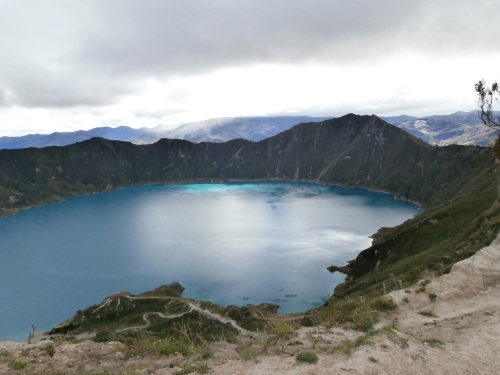
One of the many beautiful views from the loop.

And this is what you see when you look out the other way.
From Quilotoa there is one bus a day to Latacunga, but you can easily catch a local taxi to the nearby town of Zumbahua at any time. From Zumbahua busses run much more frequently or you can catch a ride with someone heading to the city and provide them with some extra pocket money. That’s what we did, as we were quickly ushered into the cab of a small truck as we headed towards the bus. At the end of the trip our driver asked for $2 or $3 total (I think it would have cost us about $3 on the bus), having got us there in record time (I was holding on with white knuckles to anything I could get my hands on as we sped around tight mountain curves. While I was having multiple minor panic attacks my companion happily chatted to our driver- he’s used to this mode of transportation from when he travels home to see his parents in another part of the highlands).

Speeding down twisty mountain roads in the front of a truck had me grabbing on for dear life…
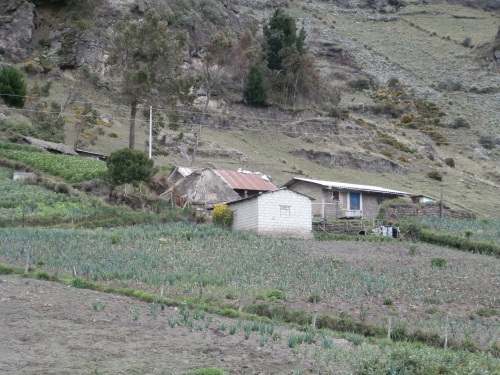
These are typical houses for the area around Quilotoa.
From Latacunga we caught a bus back to Quito, and again headed to Plaza Foch to find a hostel. That evening we took a walk through colonial Quito, which was lovely. Quito was colonized by the Spanish in the mid 1500s, and as such has a lot of history. Of note, we visited La Iglesia de la Compania de Jesus, aka la Compañía, where we had a tour and caught part of a baroque concert of sacred music (it’s always interesting to visit religious places during holy week!).

One of the many beautiful colonial period building lit up in Old Quito.
The following day I explored Quito alone, visiting the botanical gardens in Parque Carolina and reading a book and people watching in Parque El Ejido. I also got to meet up with a friend of a friend who is a native of Quito, and I really enjoyed getting a different perspective on life in Ecuador, especially hearing a different take on the current president (talk of Rafael Correa stirs up strong feelings in many Ecuadorians I spoke with). In the evening I headed to the airport, and sadly left Ecuador behind. I certainly hope to return again soon!
There are a couple of general things that I think are worth noting…
Coffee, Bananas, and Chocolate- I’ll admit that I was excited to return to a country that is well known for these three delicacies. I’ll also admit that I was somewhat disappointed by the lack of these things in Ecuador. I don’t know if all the bananas are exported (they are a major source of revenue for the country), but I ate more bananas in the airport lounges to and from Ecuador than I actually did in the country. There was plenty of other fruit, but bananas weren’t plentiful (at least not at this time of the year). Likewise, with the exception of El Quetzal chocolate in Mindo, I didn’t see any good Ecuadorian chocolate. Manicho, the quintessential Ecuadorian chocolate, is a milk chocolate and peanut candy bar, and while that was prevalent I did not see any dark chocolate for sale to the public. While Ecuador produces high quality chocolate beans, it appears they are sent out of the country to be processed and turned into expensive Swiss (or Belgian or whatever) chocolates. Likewise coffee is a major export for Ecuador, yet the coffee section in the supermarket I visited was an abomination of Nescafe and instant coffee!

Coffee selection- Are all the good beans exported? Where’s that delicious Ecuadorian coffee I was looking for?!
Food- The food in Ecuador was generally outstanding. By far the best of any of the countries I have visited in the last few months. The ingredients are fresh, food is simple, and food is a central part of community and family structure. People eat out a lot, but at simple places that are serving one of two basic ‘dishes of the day’. Some of the best meals I had cost a couple of dollars and consisted of rice, potatoes, and meat. Ecuadorians also really love soup, and the soups that frequently preceded our main dishes were generally outstanding. With the exception of strawberries after one lunch, desert did not seem common.

This plate of Menestras (beans or lentils) with pork cost me ~$3 just around the corner from the pricey Plaza Foch.
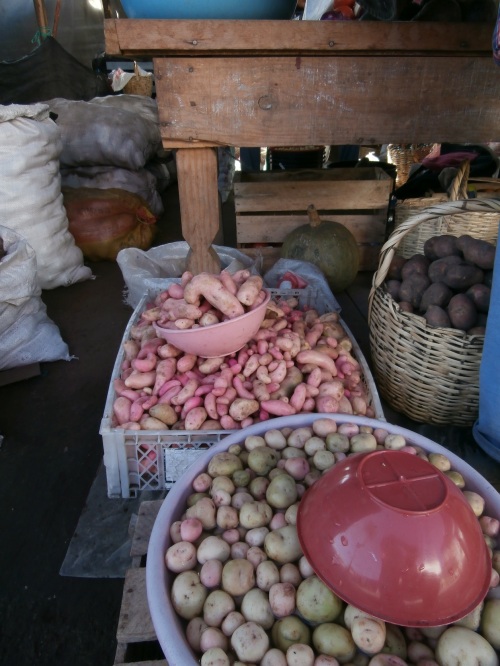
Potatoes are frequently served for lunch and dinner. They’re a traditional crop, and there are varieties that grow in the harsh Andes climate. They look quite a bit different to what you get in the store in the US!


Corn generally looks quite a bit different as well. I don’t think Monsanto had anything to do with these ears!
Street food was common, cheap, and delicious. I generally break a lot of the “food safety” rules when traveling, and I very happily ate food from street vendors while in Ecuador. Common options are grilled plantains with cheese and mango with salt. Fruit is commonly sold in plastic sleeves as snack food, and you can usually get a bag of grapes, apples, pears, citrus, or rambutans for $1 a bag. At one point I saw Avocados being sold on the street at 10 for $1. Not exactly your typical street food, but what a bargain!
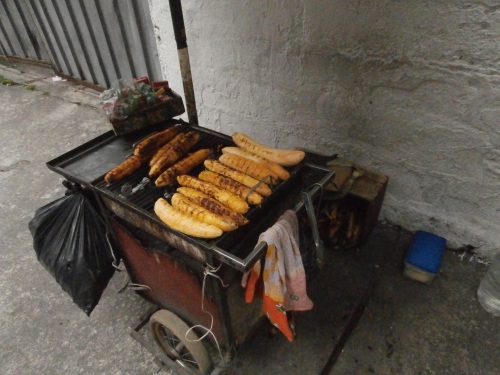
Plantains grilled on the street.
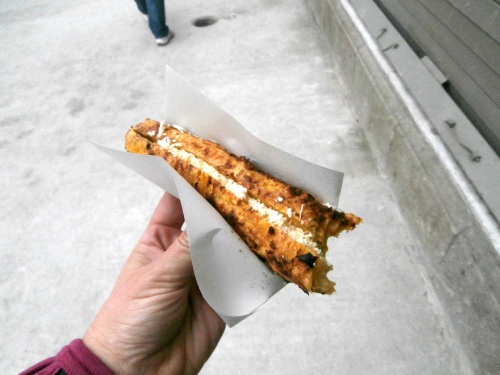
Maduros con queso- sweet plantain with cheese.

Green mango with salt. Another popular street food.

Rambutans- A curious looking fruit!

Rambutans- I hadn’t had these before, but they are very tasty!
Bags of fruit were also commonly sold on the bus, as were ice creams, chips (plantain, potato, and cassava), peanuts, and all kinds of snacks. At various bus stops vendors would hop on the bus toting their wares, hoping to make a dollar or two before hopping off at the next stop. You could even get whole meals sold in this way, such as fritadas sold in little plastic bags with wooden forks.
Juice-fresh fruit juices, or “jugos naturales” are very popular and often included as part of a meal. Common flavors are blackberry, pineapple, naranjilla, guanabana (soursop), and tree tomato. They’re frequently sweetened, but you can ask to have them with minimal or no sweetening.
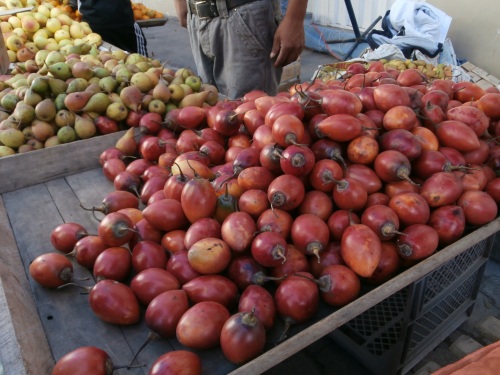
Tree tomatoes, aka Tamarillos- Solanum betaceum.
Money- Ecuador has used the American dollar as currency since 2000. I used more $1 coins during one week in Ecuador than I have in my entire lifetime in the US. Things in Ecuador are cheap, so small bills are preferred, and people frequently ask you for small and exact change. In addition to the US bills and coins, there are also Ecuadorian coins that correspond to the nickel, dime, and quarter.
Transportation- public transportation in Ecuador is cheap and fairly reliable. You can traverse the length of Quito (a lengthy ride) for 25c, and get most places by bus or taxi for very reasonable prices.

I usually just relaxed and watched the scenery go by as we rode the bus, but from time to time I would do some light reading- such as this article on the prevalence on fatty liver in children… Longtime readers will understand my interest in this topic!
A parting suggestion: VISIT ECUADOR. It is a beautiful country filled with generous and kind people. The environment is diverse and fascinating, the food is delicious. It’s easy to get to from the US, it’s easy to travel on a very limited budget, and you’ll never run out of things to see. It’s definitely helpful to speak Spanish (or to travel with someone who does), but some of the tourists we ran into had very limited Spanish and seemed to get by just fine.
The Galapagos were fascinating, but I fell in love with Ecuador when I visited the highlands. I’ve now seen two of the four regions of Ecuador, and I can’t wait to go back again… There’s so much to see and do, but perhaps next time I can make it to the Amazon!
Read Full Post »













































































